Hazuri Bagh
Hazuri Bagh (Urdu: حضوری باغ) is a garden in Lahore, Punjab, Pakistan, bounded by the Lahore Fort to the east, Badshahi Mosque to the west, the Samadhi of Ranjit Singh to the north, and the Roshnai Gate to the south. The Serai Alamgiri caravanserai formerly stood where Hazuri Bagh is now located. In the centre of the park stands the Hazuri Bagh Baradari, built by Ranjit Singh in 1818 to celebrate his capture of the Koh-i-Noor diamond from Shuja Shah Durrani in 1813.[1][2][3][4]
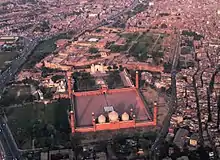
| Hazuri Bagh | |
|---|---|
| حضوری باغ | |
 The Hazuri Bagh Baradari is in the centre of the quadrangle | |
 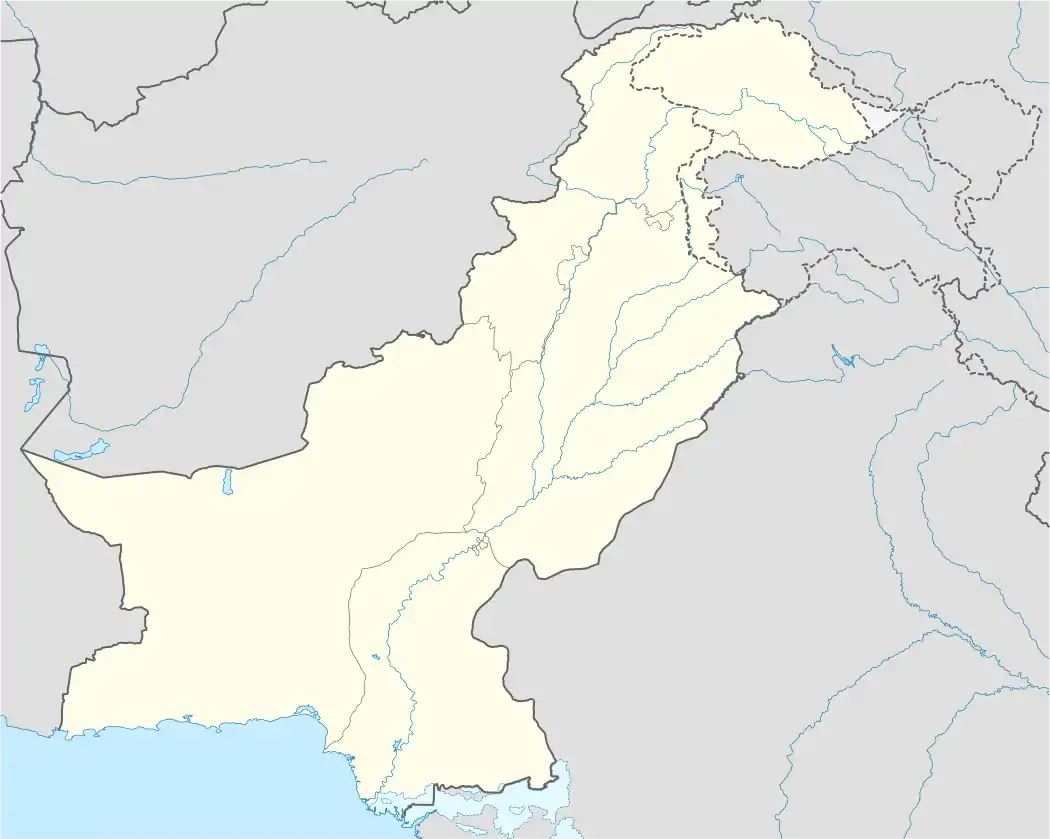 | |
| Location | Lahore, Pakistan |
| Coordinates | |
The Hazuri Bagh garden was planned and built under the supervision of Faqir Azizuddin in the traditional Mughal style layout. After its completion, it is said, Ranjit Singh, at the suggestion of Jamadar Khushhal Singh, ordered that marble vandalized from various mausoleums of Lahore to construct a baradari (pavilion) here. This task was given to Khalifa Nooruddin. Elegant carved marble pillars support the baradari’s delicate cusped arches. The central area, where Ranjit Singh held court, has a mirrored ceiling. Both the garden and the baradari, originally a 45-foot, three-storey square with a basement approached by fifteen steps, suffered extensive damage during the Sikh wars and was only reclaimed and laid out according to the original plan during the British period. On 19 July 1932, the top story collapsed and was never rebuilt or restored.[1][4]
Every Sunday afternoon, people gather in the garden to hear story tellers recite traditional Punjabi Qisse, such as Heer Ranjha and Sassi Punnun, and other Punjabi Sufi poetry.[3]
The tomb of Muhammad Iqbal lies across from the garden outside of the Badshahi Mosque.[4]
Gallery
 Hazuri Bagh is at the entryway of Badshahi Mosque
Hazuri Bagh is at the entryway of Badshahi Mosque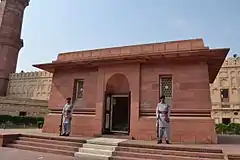 The Tomb of Allama Iqbal is located within the Hazuri Bagh
The Tomb of Allama Iqbal is located within the Hazuri Bagh
 Iqbal's tomb and the Hazuri Bagh
Iqbal's tomb and the Hazuri Bagh.jpg.webp) Hazuri bagh pavilion in 1870, with Lahore Fort in background
Hazuri bagh pavilion in 1870, with Lahore Fort in background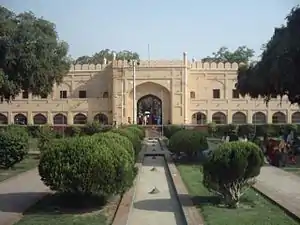 South section, with Roshnai Gate in background
South section, with Roshnai Gate in background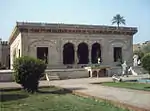
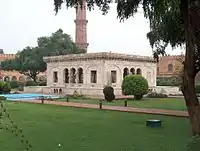 Baradari with Badshahi Mosque in background
Baradari with Badshahi Mosque in background Hazuri Bagh
Hazuri Bagh Hazuri Bagh Baradari with Lahore Fort in the background, 2005.
Hazuri Bagh Baradari with Lahore Fort in the background, 2005.
See also
References
- "Hazuri Bagh and Baradari". Asian Historical Architecture website. Retrieved 31 December 2020.
- Bansal, Bobby (2015). Remnants of the Sikh Empire: Historical Sikh Monuments in India & Pakistan. Hay House, Inc. ISBN 9384544930.
- Tania Qureshi (23 February 2018). "Lahore's Hazuri Bagh - a historic complex with a new look". Daily Times (newspaper). Retrieved 31 December 2020.
- Siddique Shahzad (28 June 2015). "Hazuri Bagh". Lahore History website. Retrieved 31 December 2020.
External links
| Wikimedia Commons has media related to Hazuri Bagh. |